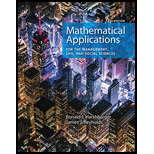
Concept explainers
Carbon dioxide emissions Using U.S. Department of Energy data for selected years from 2010 and projected to 2032, the millions of metric tons of carbon dioxide
(a) Find the function that models the rate of change of
(b) Find and interpret
Trending nowThis is a popular solution!

Chapter 11 Solutions
Mathematical Applications for the Management, Life, and Social Sciences
- 11. (a) Define the (mathematical and conceptual) definition of conditional probability P(A|B).arrow_forward12. (a) Explain tail events and the tail o-field. Give an example.arrow_forwardLet A, A1, A2,... be measurable sets. Then P(A)=1- P(A); • P(Ø) = 0; P(A1 UA2) ≤ P(A1) + P(A2); A1 C A2 P(A1) P(A2); P(UA) + P(n=14) = 1. Exercise 3.1 Prove these relations. ☐arrow_forward
- Task: Topology: Homotopy and Fundamental Groups Refer to Question 17 in the provided document. Link: https://drive.google.com/file/d/1wKSrun-GlxirS31Z9qoHazb9tC440AZF/view?usp=sharing 10 Optimization: Lagrange Multipliers Task: Refer to Question 18 in the provided document. Link: https://drive.google.com/file/d/1wKSrun-GlxirS31Z9qoHazb9tC440AZF/view?usp=sharingarrow_forwardfind three soultion independed by lagrang 2x (y + z²)p + y(2y + z²)q = Z³arrow_forwardTask: Fourier Analysis: Convergence of Series Refer to Question 21 in the provided document. Link: https://drive.google.com/file/d/1wKSrun-GlxirS31Z9qoHazb9tC440AZF/view?usp=sharing Task: Abstract Algebra: Rings and Ideals Refer to Question 22 in the provided document. Link: https://drive.google.com/file/d/1wKSrun-GlxirS31Z9qoHazb9tC440AZF/view?usp=sharingarrow_forward
- Task: Matrix Theory: Singular Value Decomposition (SVD) Refer to Question 19 in the provided document. Link: https://drive.google.com/file/d/1wKSrun-GlxirS31Z9qoHazb9tC440AZF/view?usp=sharingarrow_forwardTask: 2 Abstract Algebra: Rings and Ideals Refer to Question 22 in the provided document. Link: https://drive.google.com/file/d/1wKSrun-GlxirS31Z9qoHazb9tC440AZF/view?usp=sharing 23 Dynamical Systems: Stability of Fixed Points Task: Refer to Question 23 in the provided document. Link: https://drive.google.com/file/d/1wKSrun-GlxirS3IZ9qoHazb9tC440AZF/view?usp=sharingarrow_forward30 Laplace Transform: Differential Equation Solutions Task: Refer to Question 30 in the provided document. Link: https://drive.google.com/file/d/1wKSrun-GlxirS31Z9qoHazb9tC440AZF/view?usp=sharingarrow_forward

 Functions and Change: A Modeling Approach to Coll...AlgebraISBN:9781337111348Author:Bruce Crauder, Benny Evans, Alan NoellPublisher:Cengage Learning
Functions and Change: A Modeling Approach to Coll...AlgebraISBN:9781337111348Author:Bruce Crauder, Benny Evans, Alan NoellPublisher:Cengage Learning College AlgebraAlgebraISBN:9781305115545Author:James Stewart, Lothar Redlin, Saleem WatsonPublisher:Cengage Learning
College AlgebraAlgebraISBN:9781305115545Author:James Stewart, Lothar Redlin, Saleem WatsonPublisher:Cengage Learning- Algebra & Trigonometry with Analytic GeometryAlgebraISBN:9781133382119Author:SwokowskiPublisher:Cengage
 Big Ideas Math A Bridge To Success Algebra 1: Stu...AlgebraISBN:9781680331141Author:HOUGHTON MIFFLIN HARCOURTPublisher:Houghton Mifflin Harcourt
Big Ideas Math A Bridge To Success Algebra 1: Stu...AlgebraISBN:9781680331141Author:HOUGHTON MIFFLIN HARCOURTPublisher:Houghton Mifflin Harcourt Glencoe Algebra 1, Student Edition, 9780079039897...AlgebraISBN:9780079039897Author:CarterPublisher:McGraw Hill
Glencoe Algebra 1, Student Edition, 9780079039897...AlgebraISBN:9780079039897Author:CarterPublisher:McGraw Hill





